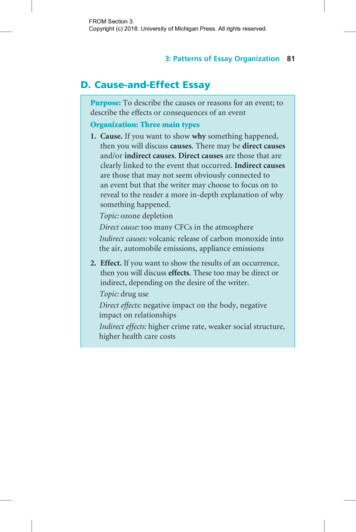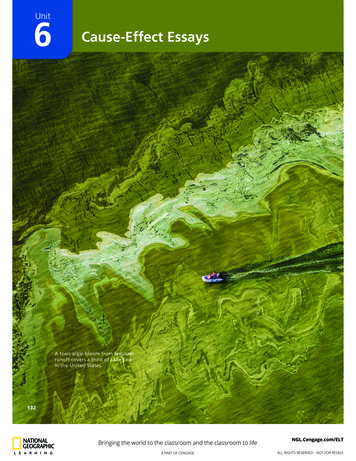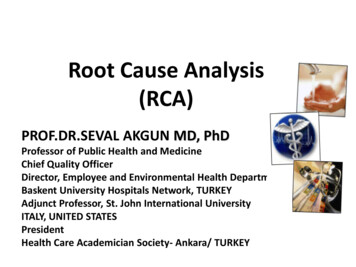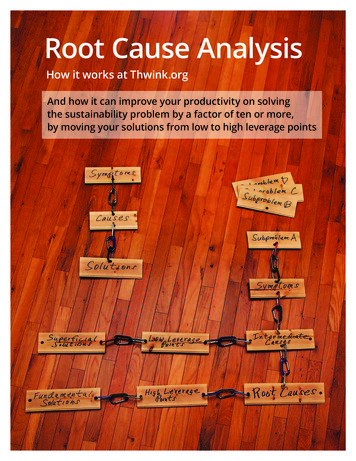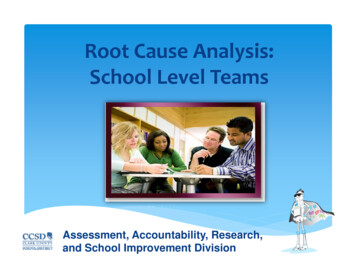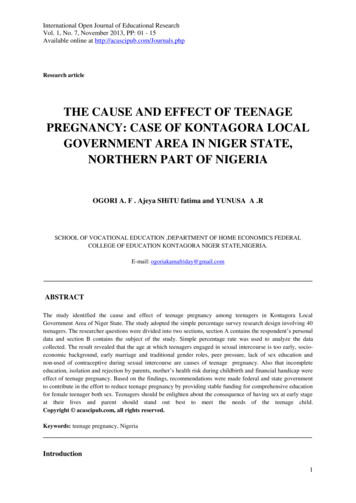
Transcription
International Open Journal of Educational ResearchVol. 1, No. 7, November 2013, PP: 01 - 15Available online at http://acascipub.com/Journals.phpResearch articleTHE CAUSE AND EFFECT OF TEENAGEPREGNANCY: CASE OF KONTAGORA LOCALGOVERNMENT AREA IN NIGER STATE,NORTHERN PART OF NIGERIAOGORI A. F . Ajeya SHiTU fatima and YUNUSA A .RSCHOOL OF VOCATIONAL EDUCATION ,DEPARTMENT OF HOME ECONOMICS FEDERALCOLLEGE OF EDUCATION KONTAGORA NIGER STATE,NIGERIA.E-mail: ogoriakamafriday@gmail.comABSTRACTThe study identified the cause and effect of teenage pregnancy among teenagers in Kontagora LocalGovernment Area of Niger State. The study adopted the simple percentage survey research design involving 40teenagers. The researcher questions were divided into two sections, section A contains the respondent’s personaldata and section B contains the subject of the study. Simple percentage rate was used to analyze the datacollected. The result revealed that the age at which teenagers engaged in sexual intercourse is too early, socioeconomic background, early marriage and traditional gender roles, peer pressure, lack of sex education andnon-used of contraceptive during sexual intercourse are causes of teenage pregnancy. Also that incompleteeducation, isolation and rejection by parents, mother’s health risk during childbirth and financial handicap wereeffect of teenage pregnancy. Based on the findings, recommendations were made federal and state governmentto contribute in the effort to reduce teenage pregnancy by providing stable funding for comprehensive educationfor female teenager both sex. Teenagers should be enlighten about the consequence of having sex at early stageat their lives and parent should stand out best to meet the needs of the teenage child.Copyright acascipub.com, all rights reserved.Keywords: teenage pregnancy, NigeriaIntroduction1
International Open Journal of Educational ResearchVol. 1, No. 7, November 2013, PP: 01 - 15Available online at http://acascipub.com/Journals.phpKontagora Emirate is inseparable from the life and times of Umaru Nagwamatse and his Sons,Abubakar Modbbo and Ibrahim Nagwamatse. In the combined life time of a little over fourty years (18581901), Nagwamatse and his protégés opened up a previously closed forestry area. Idol worship, wars among andbetween communities slave raiding and complete absence of law and order was the environment where peaceand security was restored and Islam established as the principal religion by these outstanding worriers andstatesmen.Before the arrival of fulanis, the area of what was know as Kontagora province consisted of Borgupeoples settled on the west bank of the River Niger, Yawuri and Kambari tribes in the North, Kamukawa andKambari and Dukkawa in the North, Kamukawa and Kambari in the North-East, Gwarawa in the East andSouth-East and the Nupes in the South. Before the arrival of the Fulanis, marriage is one of society’s mostimportant and basic institutions. It is the foundation of the family which is the basic unit of society.The founder of Kontagora (Umaru Nagwamatse) who practiced Islam religion was a family manaccording to Islamic injunction which says a girl should marry after her first menstruation in her father’s housebased on that the establishment of marriage started in Kontagora with some men having more than one wifewhen socialization came in some Kontagora kinsmen now limit their marriage to one wife. The cause and effectof teenage pregnancy in this local government is not as high as it used to be because of socialization andmodernization and many of those girls who held strictly to Islamic injuction have now know the importance offormal education.Nowadays, teenage pregnancy has become a growing concern and therefore various causes of teenagepregnancy has become crucial. Teenage pregnancy refers to pregnancy occurs in young girls, mostly in therange of age 13 to 17 yeas old.According to Jackie, (2012) low self-esteem is among the causes of teenage pregnancy. Children whoare not shown love and affection from parents will seek it out with their peer group. Many adolescents reportfeeling pressured by their peers to have sex before they are married.According to Patrick (2010), the transition from childhood to teenage may cause unstable emotions tosome teenagers, and this may cause complex teenage psychology break on teenagers. Complex teenagepsychology can results an immature and irresponsible behaviour which in turn may be another cause of teenagepregnancy. Meanwhile, weak family bonding fail to provide the emotional support that they need during theirtransitional term. This lack of attention and affection from the family causing depression and pushing them tolook for love and attention from others especially from the opposite sex.A substantial proportion of the members of every society in the developmental stage termed“adolescence”, otherwise called “teenage”, it is a transitional period between the end of childhood and thebeginning of adulthood or maturity. It occurs roughly between the age of 13-17, this is a period in everyperson’s life when all seems to be confused, when nothing is good in the eyes of the perceiving adolescent;when she is on “means” land (Lawin, 2006). When her role is not clearly defined. It is a period when girl startsto menstruate. Adolescent describe this period as a period of body contour and stature resembling that an adultmate,(Murphy, 2007), while adults customarily refer to them as children Nigeria adolescents now insists on beingtreated as adults while parents may dismiss them as being too young to live alone, they are clearly independenceand the right to have privacy. The Kontagora teenager is therefore caught in a field of overlapping forces andexpectation of all of which constitute on real test for individual identity.Pregnancy that happened at such as frail age is predominantly, due to lack of sex education therefore,parents responsibility to deliver an adequate sex education to their teenage daughters. Reproductive healthsituations are also important to be imparted to the young child so that they become aware of the various aspectsrelated to sex and pregnancy.According to Count (2010), adolescent marks the onset of sexual maturity. It is period time for them toshow interest to the opposite sex and curiosity about the much topics of sex. Irresponsible and careless approachof mass media has also contributed in sex occurrence among teenagers.Carrera (2012) said, unrestricted interaction with the opposite sex ignite the sparks of lust in teenagersvery easily, especially when alcohol and drugs are involve. Also Ideir (2011) said high rates of teenagepregnancy usually associated to such conditions of under education, income levels, and childhood environment,2
International Open Journal of Educational ResearchVol. 1, No. 7, November 2013, PP: 01 - 15Available online at http://acascipub.com/Journals.phpbecause of negligence towards birth control. Sexual abuse of teenage girls is also one of the most disgracefulcauses of teenage pregnancy. Teenage parents of teens do not have financial resource to cater for their babies.They usually have to rely on the families and relatives to assist them. This lead to the break down in vocationalexpulsion from school and may not have the opportunities of being re-absorbed to the school system, this breakcan hinder the future development opportunities as well as the quality of life the person, family/nationsometimes, however, teenage mothers are not mature to meet emotional and social needs of children. They mayfeel Isolated and deserted by their friends who continued with their education, contributing to psychologicalblinks.According to Melissa (2012), teenage pregnancy could lead to incomplete education, unemploymentand other numerous emotional traumas. Early motherhood had been linked to effects the psychologicaldevelopment of the child adversely. Beside psychological physical risks cannot be ignored.Teenage girls body is not as developed as adult women in term of childbearing. Thus, they are often toface certain complications during pregnancy. Lack of sexual education caused teens get abortions since theyrealize that they are not ready yet to take responsibility to be a parent at such a young age and they still havemany things to chase in life. The chance of maternal death cannot be ruled out in effecting teenage pregnancy bychild.According to Marnach et al (2013) medically, teenage pregnancy maternal and prenatal health is ofparticular concern among teens who are pregnant or parenting. The world wide incidence of premature birth andlow birth weight is higher among adolescent mothers. Teenage mothers between 15-19 years old were morelikely to have anemia, preterm delivery and low birth than mothers between 20-24 years old physiologically forthe child as well as the mother. The mother can become easily frustrated and find violence is the way toovercome grief. She might become distraught thinking that she is a failure as a parent when seeing the reactionof her after being beaten. The teen mother might become depressed and consider suicide.The percentage of teenage pregnancy in the society is growing at along rate. It is perceived that lack ofadequate knowledge about sex education to teenage girls make them to be sexually active which eventuallyleads to pregnancy. Teenage pregnancy has pregnancy has been found to have negative and social long lastingeffects on the life of the adolescents. It is in the light of this that this study is carried out to examine the causesand effects of teenage pregnancy in Kontagora Local Government.Objective of the StudyThe objectives of the study are as follows:1.To identify the causes of teenage pregnancy2.To identify the effects of teenage pregnancy3.To identify strategies to curb causes and effects of teenage pregnancy in Kontagora LocalGovernment.Research Question1.What is the concept of teenage pregnancy?2.What are the causes of teenage pregnancy?3.What are the causes and effects of teenage pregnancy in Kontagora Local Government?Research MethodologyThis chapter discusses the method adopted to carry out the research in order to get detailed informationabout the cause and effect of teenage pregnancy in Kontagora Local Government Area.Research DesignA descriptive researcher design (survey) method will be sued for this study. This is because the studyinvolves collecting data from a Kontagora Local government Area portion as of a population and generalizingthe findings on the entire population Niger StateSample and Sampling TechniqueThe sampling method adopted for this study is the random sampling technique. A total population of 40teenagers were used.POPULATION OF the Study3
International Open Journal of Educational ResearchVol. 1, No. 7, November 2013, PP: 01 - 15Available online at http://acascipub.com/Journals.phpA self designed instrument will be used to collect data for this study. The questionnaire was designedinto two sections, section A comprises of the respondents bio-data and section B comprises of questions relatedto the subject matter of the study. The questions were structured on a four point liker scale format of stronglyagreed (SA), agreed (A), strongly disagreed (SDA) and disagreed (DA) on compassing concept causes andeffects of teenage pregnancy in Kontagora Local Government Area town and then collected after immediatelyon the sport after 30 minutes of waiting. This was done for each 50 responded in three days.Procedure for Data CollectionThe questionnaire were administrated and by the researcher among teenage girls and boys in KontagoraLocal Government.Procedure for Data AnalysisThis deals with the presentation of the data collected through the use of frequency distribution tablesand percentages on conversions.ResultsTableTable 1: Concept of teenage pregnancy. Teenage transitional 65%27.5%7.5%100%In the table above, 65% of the respondents strongly agreed that teenage transitional period 27.5% ofthe respondents agreed wit the same view, non of the responds strongly disagreed with the view, but 7.5% of therespondents disagreed. This implied that teenage is the transition between childhood to adult hood.Table 2: Delicacy of teenage ntage25%45%15%15%100%The table above shows that 25% of the respondents strongly agreed that delicacy of teenage pregnancy45% the respondents agreed with the same view, in contrast 15% of the respondents strongly disagreed thatteenage pregnancy is not delicate while 15% of the respondents disagreed with also above statement. From thefoundlings the frequency of the highest respondents agreed with the above statement, measured the highestfrequency.This implied that most teenage pregnancy is delicate.Table 3: Occurrence of teenage pregnancy in under aged4
International Open Journal of Educational ResearchVol. 1, No. 7, November 2013, PP: 01 - 15Available online at lFrequency14148440Percentage35%35%20%10%100%Above showed that 35% of the respondents strongly agreed that occurrence of teenage pregnancy inunderaged, 35% of the same sample respondents agreed with the above statement, in contrast, 20% of therespondents strongly disagreed with the same view while 10% of the same respondents disagreed that teenagepregnancy does not occurred in underage girls.This shows that majority of the respondents strongly agreed that occurrence of teenage pregnancy inunder aged.Table 4: High level of teenage pregnancy in Kontagora Local entage30%37.5%17.5%15%100%Table 4.1.4 above sows that 30% of the sample respondents strongly agreed that high level of teenagepregnancy in Kontagora Local Government Subsequently, 37.5% of the respondents agreed with the same view,in contrast, 17.5% of the respondents strongly agreed with the statement while 15% of the respondents disagreedwith the statement.This indication shows that majority of the respondents agreed that high level of teenage pregnancy inKontagora Local GovernmentTable 5: Rejection level of teenage pregnancy Kontagora Local entage25%20%22.5%32.5%100%From the above table show that 25% of the respondents strongly agreed that rejection level of teenagepregnancy Kontagora Local Government 20% of the same respondent agreed with the same view, in contrast,22.5% of the respondents strongly disagreed that teenage pregnancy is rejected in Kontagora, also 32.5% of thesame respondents disagreed with the same view.This implied that with the rejection of teenage pregnancy in Kontagora can reduce teenage sexualbehaviour.Causes of teenage pregnancyTable 6: Caused by Socio-economic background5
International Open Journal of Educational ResearchVol. 1, No. 7, November 2013, PP: 01 - 15Available online at ercentageSA1947.5%A1640%SD37.5%DA25%Total40100%The table shows that 47.5% of the respondents strongly agreed that teenage pregnancy is caused bysocio-economic background, 40% of the same respondents also agreed with the same views, in contrast, 7.5% ofthe respondents strongly disagreed that socio-economic background could not caused teenage pregnancy while5% disagreed the above statement.Therefore, the highest respondents were in support of the above statement. This implies that socioeconomic background causes teenage pregnancy.Table 7: Caused by Peer ntage35%27.5%25%12.5%100%From the table above shows that 35% of the respondents strongly agreed that peer pressure causes teenagepregnancy 27.5% of the respondents also agreed with the same view, while 25% of the respondents stronglydisagreed and 12.5% of the respondents also disagreed with the statement. Fortunately the highest percentage ofthe respondents supported that peer pressure causes teenage pregnancy.This implies that teenage pregnancy could be affected by peer pressure.Table 8: Caused by Lack of Sex ntage62.5%25%5%7.5%100%This shows that 62.5% of the sample respondents strongly agreed that lack of sex education causesteenage pregnancy, 25% of the same respondents agreed with the above statement, 5% of the respondentsstrongly disagreed while 7.5% of the respondents supported or responded positively.This implies that good knowledge about sex education could minimize teenage pregnancy.Table 9: The non-used of contraceptives during sexual 5%35%15%6
International Open Journal of Educational ResearchVol. 1, No. 7, November 2013, PP: 01 - 15Available online at 0%This shows that 32.5% of the respondents strongly agreed that non-used of contraceptives during sexualintercourse, 35% of the respondents also agreed with this statement, in contrast 15% of the respondents stronglydisagreed with above statement while 17.5% of the respondents also disagreed with the statement.This implies that non-used of contraceptives which eventually lead to teenage pregnancy.Table 10 : Caused by early marriage and traditional gender e25%40%15%20%100%The table shows 25% of the respondents strongly agreed that early marriage and traditional gender roles,40% of the respondents also agreed, while 15% of the same respondents strongly disagreed and 20% of therespondents disagreed with the statement positively, 40% of the respondents measured higher implies that theabove statement in table 4.10 could caused teenage pregnancy.Effect of teenage pregnancyTable 11 : Incomplete tage62.5%22.5%15%100%Above shows that 62.5% of the respondents strongly agreed that teenage pregnancy could affecteducation, 22.5% of the same respondents agreed with the views but 15% strongly disagreed while non of therespondents disagreed with the statement.This implies that careless conduct by teenage could affect her education.Table 12: Mother’s health risk during entage57.5%25%7.5%10%100%7
International Open Journal of Educational ResearchVol. 1, No. 7, November 2013, PP: 01 - 15Available online at http://acascipub.com/Journals.phpIn the table above shows that 57.5% of the respondents strongly agreed that during childbirth teenagemother’s health is at stake, 25% of the respondents also agreed with the same statement, while 7.5% of therespondents strongly disagreed, but 10% of the same respondents disagreed.This implies that the statistical implication shows that teenage mothers are at risk during childbirth.Table 13 : Lack of love affections and care from both tage42.5%30%5%22.5%100%In table 4.1.13 of the above, the research carried out show that 42.5% of the respondents stronglyagreed that love, affections and care from both parents affect a teenage child, 30% of the same respondentsagreed while 5% of the respondents strongly disagreed with the above statement, and also 22.5% of therespondents disagreed with the same statement above.Therefore, highest population of respondents children were not shown love, affections and are by theboth parents.Table 14: Isolation and rejection by age35%47.5%7.5%10%100%The above table shows that 35% of the respondents strongly agreed that when teenage girl becomes pregnantthere would be isolation and rejection from parents 47.5% of the respondents agreed, in other word, 7.5.% of therespondents strongly disagreed with the above statement while 10% of the respondents disagreed also.This implies that most teenage pregnancy are rejected by parents.Table 15: Isolation and rejection by 840Percentage37.5%35%7.5%20%100%The table show that 37.5% of the respondents strongly agreed that they were isolated and rejected by theirfriends/community, 35% of the respondents agreed wit the same view, in contrast, 7.5.% of the respondentsstrongly disagreed while 20% of the respondents disagreed.This implies that isolation and rejection by friends/community affect teenage pregnancy.8
International Open Journal of Educational ResearchVol. 1, No. 7, November 2013, PP: 01 - 15Available online at http://acascipub.com/Journals.phpTable 16: Financial tage42.5%25%12.5%20%100%This shows that 42.5% of the respondents strongly agreed that due to teenage pregnancy they were financiallyhandicapped, 25% of the respondents agreed with the statement too, while 12.5% strongly disagreed with thestatement above and 20% of the respondents disagreed also.In the research a positive responses measured the highest percentage, which signifies that any teenagewho is involved in teenage pregnancy is financially handicapped.Table 17: Psychopaths in the local govt 0%35%7.5%17.5%100%The above shows that 40% of the respondents strongly agreed that teenage pregnancy lead to psychopath,35% of the respondents agreed with the statement, 7.5% of the respondent strongly disagreed with the statementand 17.5% of the respondents disagreed with the above statement.Although, this differences might be based on individual’s belief.Discussion and FiningsThe findings, revealed that teenage pregnancy is rampared among teenagers in Kontagora LocalGovernment Area of Niger State. There had been observed in some of the tables below.Table 1. Shows that the percentage for item was 65% which is the highest percentage of teenage is thetransition between childhood to adulthood. The findings is in agreement with Berger (1991) asserted thatteenage is the transition stage a difficult stage and a delicate stage that needs to be handled with caution by bothteenager and all those who have influence over him/her especially the parents.Table .2 revealed that the majority of the respondents were 45% agreed that teenage pregnancy isdelicate. According to Tips (2005) said teenage is a delicate stage of life when both boys and girls may includethemselves in certain irresponsible activities and end up being unexpected mothers and fathers.WHO (1995) observes that teenagers have complications related pregnancy and childbirth and areamong the leading causes of mortality of age (15-22 years) in many parts of the world.Table .3 reveals that the highest respondents (35%) strongly agreed that teenage pregnancy occurring inunderaged girls. Oguguo (1996) said is the pregnancy of young immature girls of secondary school age, usuallyranging from thirteen to nineteen years of age. He further asserted that the number of girls under 16 inKontagora given birth were 148? Up 39% since 1967 the numbers of pregnancy occurring to underage girlswere over 90 per year.Table 4 indicates that teenage pregnancy is high in Kontagora Local Government Area. This flinging isinline with the view of Joseph (2008) who pointed out that a strong association between teenage pregnancy and9
International Open Journal of Educational ResearchVol. 1, No. 7, November 2013, PP: 01 - 15Available online at http://acascipub.com/Journals.phplocal government level me assures of religiosity in Kontagora rate of pregnancy to teenage girls are stronglypredicated by conservative religious beliefs.Table 5 shows that majority of the respondent’s disagreed with the statement. According to Mommy(2011) found out that not all pregnant teens are rejected from society.Table 6 reveals causes of teenage pregnancy and one of the causes is socio-economic backgroundwhich is agreed by the majority of the respondents with the highest percentage of (47.5%). Joubert (2008)reveals that the current socio-economic in Nigerian means that those who live in poverty are often exposed tomore “live” sexual activity because families are required to live in small houses where there is distinct lack ofprivacy for the parents, children that grow up under that situation can easily engage themselves on sexualactivity as soon as they entered the puberty stage.According to Coley et al (1998) postulated that girls living in poor socio-economic background with anearly onset of menarche will engage early in sexual behaviour. Based on this finding, it can be argued thatsocioeconomic background may play a role in cause of teenagers to engage in early sexual behaviour, thusincreasing their chances of falling pregnant.Table 7 shows that percentage of respondents (35%) peer pressure who indicated that teenagepregnancy could be as a result of peer pressure. According to Albert (2007) states that there are social pressuresthat push the teens toward falling pregnant. Many teens engage in unhealthy activities just so that their upperswill notice them or so that they may fit in, peer pressure to engage in sexual activity is so common, a variety ofterms refers to the behaviour, such as “hooking up”, “booty calls” or referring to some one as a friends withbenefits?Some teenage girls have said to be pressured into having sex with their boys friends at a young age, andyet no one taught teens how to deal with this pressure or to say “no”.Table 8 shows the causes of teenage pregnancy. Most of the respondents strongly agreed that lack ofsex education is made possible for teenage pregnancy. This finding agrees with the findings of miller (2006)stated that lack of education on safe sex, either on the side of the parents or the educators, may lead to teenagepregnancy. Many teenagers are not taught about methods of birth control.Okonkwo (2004) associates teenage pregnancy as lack of adequate sex education. Transitionally, sexeducation has consisted of parents explaining the facts of human reproduction to children reaching the age ofadolescence.Table 9 shows that the data revealed positive response to the statement, that the non-used ofcontraceptives during sexual intercourse is a determinant of teenage pregnancy in Kontagora. The findings is inagreement with Wikipedia the free encyclopedia (2008) stated that some teenagers fall pregnant because theylack information or access to conventional method of preventing pregnancy. Inexperienced teenagers may usecondoms incorrectly or forget to take oral contraceptives, contraceptives failure rates are higher in teenagers,particularly girls from the poor social backgrounds.According to Chlers (2003) found that the majority of teenagers who end up becoming pregnant lackedinformation about contraceptive and emergency conceptives.Table 10 determine the factors influencing teenage pregnancy. The table revealed that majority of therespondents (40%) agreed that early marriage and traditional gender roles are causes of teenage pregnancy. Thisfinding is in line with Moore & Rosenthal (1993) stated that early marriage and traditional gender roles areimportant causes in the rate of teenage pregnancy is often seen as a blessing because it is proof of the youngwoman’s fertility. In the northern part of this country teenage marriages are common, one can expect to alsoexperience higher levels of the teenage pregnancies. Early marriage and pregnancy is more common intraditional rural community of Kontagora compared to the rate in cities.In table 11 indicates the opinion of the respondents on the item statement which says the effect ofteenage pregnancy is incomplete of education 62.5% of the respondent strongly agreed. According toRothenberg and Weissman (2002) fund that 7 out of 10 females who become teenage mothers did not graduatefrom high school. Less than one-third of teenage females giving birth before age 18 ever complete high schooland the younger the pregnant teenagers are, the less likely they are to complete high school.Also (Kosha, 2001) revealed that nationally, about 25% of teenage mothers have a second baby withinone year of their first baby, leaving the prospect of high school graduate improbable. However, if a parenting10
International Open Journal of Educational ResearchVol. 1, No. 7, November 2013, PP: 01 - 15Available online at http://acascipub.com/Journals.phpfemale can delay a second pregnancy, she becomes less at risk for dropping out of school and her chance offinishing high school increases.Table 12 shows that opinions of the respondents on the item statement which says mother’s health is ata risk during childbirth 57.5% respondents agreed along side. This finding is inline with the finding ofGeronimus (1996) observed that early pregnancies have also been associated with higher than risk of morbidityduring childbirth and high incidences of material and prenatal deaths. This is because child bearing has beenassociated with many social and health risks that are sometimes very serious, and therefore, need targeting fromboth the curative and preventive health strategies.Table 13 reveals that out of the respondents 42.5% of the respondent’s expressed their degree ofagreement, strongly agreed and agreed respectively. The finding is in agreement with Bissell (2000) suggestedthat teenage parents are less likely to stimulate their infant through affectionate behaviours such as touch,smiling and verbal communication, or to be sensitive and care toward his/her needs.Table 14 indicates that 47.5% of the respondents agreed that the effect of teenage pregnancy isisolation and rejection by parents. This finding is inline with Visser and Roux (1996) found that many teenagemothers felt that their pregnancy upset their parents. Fathers tendered to be angered by their daughters’pregnancies. In some cases this anger would even lead to the fathers rejection to chase their teenage daughtersout of the house.Mpetshwa’s (2000) study repotted having experienced a lot of ill treatment from their family members,especially the
leads to pregnancy. Teenage pregnancy has pregnancy has been found to have negative and social long lasting effects on the life of the adolescents. It is in the light of this that this study is carried out to examine the causes and effects of teenage pregnancy in Kontagora Local Government. Objective of the Study




